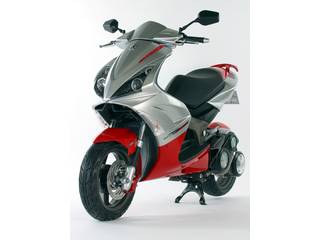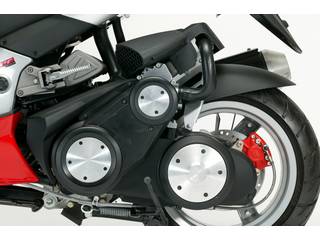After writing a few articles about the possibility of applying turbocharging to motorcycle engines, I received several email from readers asking ‘what about superchargers’. I’ve been meaning to write an article about superchargers, but in the meantime it appears that Peugeot has, at least to some extent, answered the question for me.

For those who don’t know what a supercharger does, it works basically the same way as a turbocharger – that is, a rapidly spinning bladed compressor wheel forces compressed air into the intake tract, providing increased power and torque. The difference is, the compressor on a supercharger is powered by an accessory belt driven off the motor’s crankshaft (sometime geared up or down by a small internal drive section), while a turbocharger’s compressor is propelled by exhaust gas exiting the motor. While some believe that a supercharger begins to make boost ‘instantly’ (ie right at idle), this isn’t true – the compressor has to be spinning at a certain RPM to make ‘boost’ (pressurize the intake tract to greater than atmospheric pressure), and the RPM of the compressor depends on the RPM of the motor (sometimes varied by the aforementioned gear drive). However, it is true that superchargers tend to make boost earlier and deliver power in a more linear fashion than turbochargers.
The drawback is that superchargers often have trouble operating evenly over the entire RPM range. Set up a supercharger that will begin making boost so early in the RPM range that it is practically seamless from idle, and that supercharger will tend to ‘run out of breath’, so to speak, at higher RPM. Alternately, a supercharger designed to provide enough air to feed the motor at high RPM may exhibit some of the same characteristics commonly attributed to ‘turbo lag’ – that is, the motor will not be receiving pressurized air at low RPM, leading to sluggish acceleration until the point when the supercharger kicks in.

Nevertheless, superchargers do have many advantages, as Peugeot has aptly demonstrated with the supercharged 125cc motor in their Jetforce Compressor scooter. Unfortunately MD hasn’t had the chance to test the Jetforce (it is available only in Europe), but reports we’ve read state that the Compressor motor makes smooth, seamless torque, and provides power equal to or surpassing that of many 250cc scooters sold in the same markets. All this accompanied by the trademark gear whine of the spinning supercharger.
The supercharger is at its best in a bike like this – one that doesn’t operate over an extremely wide RPM range, and thus will not have problems with ‘running out of breath’ at high RPM. The supercharger allows the Jetforce to make the power of a 250, while likely achieving similar fuel economy (when cruising, at least) to most 125s. Best of both worlds, right?
So how can supercharging technology be applied to motorcycles? I doubt we’ll start seeing supercharged sportbikes anytime soon, but a supercharged cruiser engine would be a spectacular idea – I believe there are a few aftermarket companies already doing this with Harley-Davidson motors. Another good fit would be a small, lightweight entry-level machine, possibly a supercharged 250cc or 300cc (the only problem here would be keeping the costs down). Whatever form it comes in, I believe that forced induction will start to make inroads into the motorcycle market in the next several years – just look at the increasing number of forced-induction automobiles being released every year.





